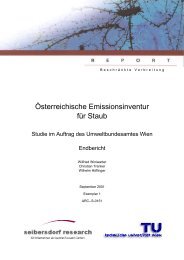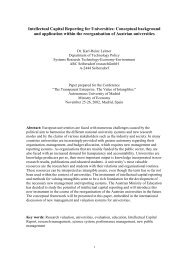ALPMON FINAL REPORT - ARC systems research
ALPMON FINAL REPORT - ARC systems research
ALPMON FINAL REPORT - ARC systems research
You also want an ePaper? Increase the reach of your titles
YUMPU automatically turns print PDFs into web optimized ePapers that Google loves.
Contract ENV4-CT96-0359 <strong>ALPMON</strong><br />
Together with pre-processing (report to WP 8 or 12) a photo-like image is developed. This fusion<br />
image was used for visual interpretation (monitoring of landscape changes), as background (visual<br />
information) in the tourist information system and for visualisation tasks like a 'fly through'.<br />
2.3.1.3.1 Task: tourist information system for hikers<br />
Tourists who come to the area of Tarvisio are mostly hiking tourists. The main season for visits is the<br />
summer. Therefore, the main attention was given to "hiking-tourism". For hiking-tourism it is shown<br />
how remote sensing data and GIS technology can be used for tourist information. An information<br />
system was developed that allows the tourists to choose routes freely and get further information for<br />
these. This additional information is the altitude profile of the trail, how much of the trails length lies on<br />
ground with a particular aspect, and how much of the route goes through forest or open area.<br />
A tourist information system is an open system: More ideas can be added. Further ideas, also with<br />
regard to local public transport service, are given by FISCHER (1998) and FISCHER et al. (1998). For<br />
example, the Swiss hiking trails SAW asked a company to develop an information system that allows<br />
management and analysis of their hiking trails. As a result, this information system is used not only by<br />
the administration but also for tourist information (KROMER et al. 1999). ZIPF (1999) attempted to<br />
interest the tourists in the history of the city of Heidelberg with three-dimensional city sceneries from<br />
different eras.<br />
Such an information system can be used in a variety of ways and places: It can of course be made<br />
available at the Tourist Office in the region itself; it could be used via Internet or in travel agencies. The<br />
presentation in the Internet or travel agency would demand different software. These would have to be<br />
"stand alone" solutions.<br />
The example introduced in this report was developed in order to show up some possibilities. In this part<br />
of the application study for <strong>ALPMON</strong>, both the fusion image and the classification result 'crown closure'<br />
were used. The information system was build up with ArcView 3.1. The surface adaptation was created<br />
with the dialog designer, the programming was done with the ArcView-inherent language AVENUE.<br />
Further information can be requested with the persons responsible at the University of Freiburg.<br />
Result:<br />
Figure 4 is meant to give an impression about the possibilities of the developed hiking information<br />
system. A hiker has now the possibility to choose a hiking route by himself. For this purpose, he<br />
touches the button "Routen wählen" (choose route). A menu then appears that helps the hiker to lay<br />
out his route and get further information about that route. Several routes can be chosen. These hiking<br />
routes can be chosen freely. Points wished to be reached should be marked here. At least a startingand<br />
an end point must be chosen. Additionally as many intermediate points as desired can be set. In<br />
this way some routes can be tried out by the tourist. The chosen routes are listed behind the item<br />
'Routen:' (routes:) in a dropdown menu and can be called again separately. Under the dropdown menu<br />
in which the individual routes are listed, the routing distance is announced for the selected route. The<br />
routes are tracked in the background with the network analysts function 'Find Best Route'. This<br />
function searches the shortest connection between the chosen points.<br />
After a route has been laid out further information about it can be asked. In our example, the following<br />
possibilities were programmed: Profile chart, exposure and shares of forest / open land. Latter<br />
describes how long the route leads through closed forest, open land and so forth. The same is<br />
computed concerning exposure. The altitude profile gives a view of gradients, differences in levels and<br />
its distribution on the route (Figure 4).<br />
JR, RSDE, ALU, LMU, Seibersdorf, WSL 27




